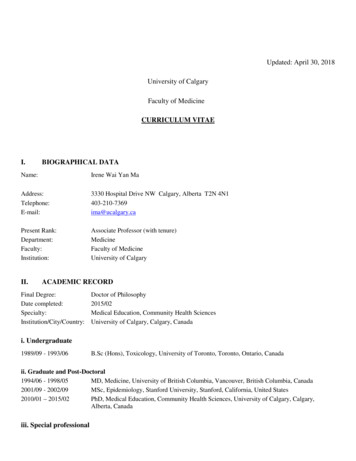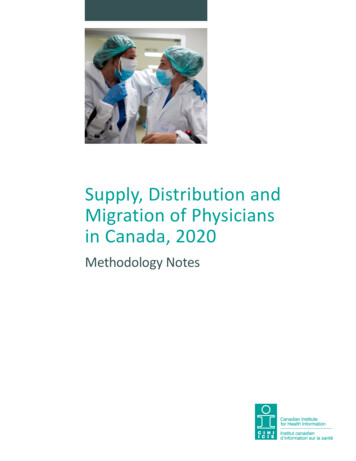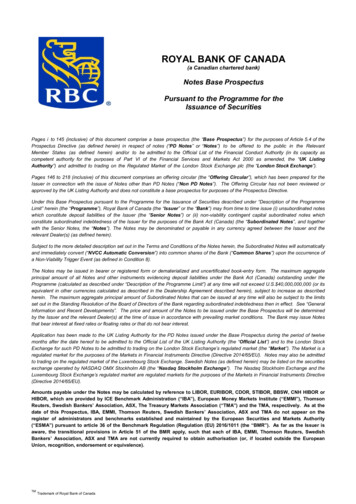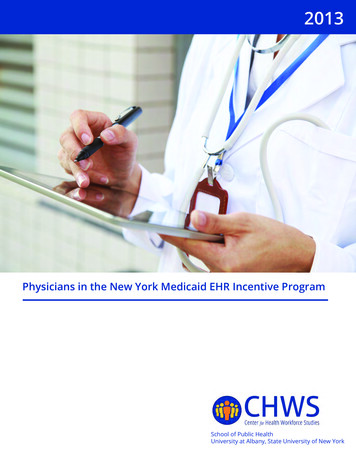
Transcription
Summary reportPhysicians in Canada, 2019
Production of this document is made possible by financial contributions from Health Canada and provincial and territorialgovernments. The views expressed herein do not necessarily represent the views of Health Canada or any provincialor territorial government.Unless otherwise indicated, this product uses data provided by Canada’s provinces and territories.All rights reserved.The contents of this publication may be reproduced unaltered, in whole or in part and by any means, solely for non-commercialpurposes, provided that the Canadian Institute for Health Information is properly and fully acknowledged as the copyright owner.Any reproduction or use of this publication or its contents for any commercial purpose requires the prior written authorizationof the Canadian Institute for Health Information. Reproduction or use that suggests endorsement by, or affiliation with,the Canadian Institute for Health Information is prohibited.For permission or information, please contact CIHI:Canadian Institute for Health Information495 Richmond Road, Suite 600Ottawa, Ontario K2A 4H6Phone: 613-241-7860Fax: 613-241-8120cihi.cacopyright@cihi.caISBN 978-1-77109-969-1 (PDF) 2020 Canadian Institute for Health InformationHow to cite this document:Canadian Institute for Health Information. Physicians in Canada, 2019. Ottawa, ON: CIHI; 2020.Cette publication est aussi disponible en français sous le titre Les médecins au Canada, 2019.ISBN 978-1-77109-970-7 (PDF)
Table of contentsAbout CIHI’s physician data. . . . . . . . . . . . . . . . . . . . . . . . . . . . . . . . . . . . . . . . . . . . . . . . . . . 4More information . . . . . . . . . . . . . . . . . . . . . . . . . . . . . . . . . . . . . . . . . . . . . . . . . . . . . . . . . . . 5Highlights . . . . . . . . . . . . . . . . . . . . . . . . . . . . . . . . . . . . . . . . . . . . . . . . . . . . . . . . . . . . . . . . 6Physician information and COVID-19. . . . . . . . . . . . . . . . . . . . . . . . . . . . . . . . . . . . . . . . . . . . 8Supply, distribution and migration . . . . . . . . . . . . . . . . . . . . . . . . . . . . . . . . . . . . . . . . . . . . . . 9Physician supply . . . . . . . . . . . . . . . . . . . . . . . . . . . . . . . . . . . . . . . . . . . . . . . . . . . . . . . 10Physician demographics . . . . . . . . . . . . . . . . . . . . . . . . . . . . . . . . . . . . . . . . . . . . . . . . . 14International medical graduates. . . . . . . . . . . . . . . . . . . . . . . . . . . . . . . . . . . . . . . . . . . . 19Physician payments and utilization . . . . . . . . . . . . . . . . . . . . . . . . . . . . . . . . . . . . . . . . . . . . 23How much are physicians paid?. . . . . . . . . . . . . . . . . . . . . . . . . . . . . . . . . . . . . . . . . . . . 24Physician full-time equivalents. . . . . . . . . . . . . . . . . . . . . . . . . . . . . . . . . . . . . . . . . . . . . . . . 29Types of physician remuneration. . . . . . . . . . . . . . . . . . . . . . . . . . . . . . . . . . . . . . . . . . . 31Fee-for-service utilization. . . . . . . . . . . . . . . . . . . . . . . . . . . . . . . . . . . . . . . . . . . . . . . . . . . . 35Appendix: Text alternatives for figures. . . . . . . . . . . . . . . . . . . . . . . . . . . . . . . . . . . . . . . . . . 38
Physicians in Canada, 2019About CIHI’s physician dataCollecting and reporting physician information assists decision-makers in health human resource planning, as wellas in the distribution and funding of physicians. Information on the supply, distribution and migration of physiciansfrom the data sources used for this report is available as far back as 1968, and information on physician serviceutilization and payments is published from 1996–1997 onward. The Canadian Institute for Health Information (CIHI)has collected this information since its inception in 1994, and has been reporting on it since 1997.The Physicians in Canada release provides readers with a complete set of documents for physician-related data onthe supply and distribution of physicians, their payments and the services they provide.To ensure that our work reflects priority needs, we invite our readers to join the discussion using CIHI’sFacebook page (facebook.com/CIHI.ICIS), Twitter account (twitter.com/CIHI ICIS) or email (physicians@cihi.ca).Any questions regarding this publication should be directed toProgram LeadPhysician InformationCanadian Institute for Health Information495 Richmond Road, Suite 600Ottawa, Ontario K2A 4H6Phone: 613-241-7860Fax: 613-241-8120Email: physicians@cihi.caOr visit CIHI online at cihi.ca.4
Physicians in Canada, 2019More informationThe following physician products are available on CIHI’s website: Physicians in Canada, 2019 (report) National Physician Database, 2018–2019 (payments and utilization data tables, historical paymentsand utilization data tables, methodology notes) Physician Services Benefit Rates, 2018–2019 (data tables, methodology notes)A profile of physicians in Canada, 2019 (infographic)Supply, Distribution and Migration of Physicians in Canada, 2019 (data tables, historical data tables,methodology notes)The following health workforce products are also available on CIHI’s website: Nursing in Canada, 2019: A Lens on Supply and Workforce (report)A profile of nursing in Canada, 2019 (infographic)Nursing in Canada, 2019 (data tables, methodology notes)Health Workforce in Canada, 2019 (Quick Stats)Canada’s Health Care Providers, 2014 to 2018 (data tables, methodology notes)Feedback and questions are welcome at physicians@cihi.ca.5
Physicians in Canada, 2019HighlightsThis report contains information on the supply of physicians in Canada, physician service utilizationand payments to physicians that are administered through the provincial and territorial medical careplans. Data on the supply, distribution and migration of physicians is as of December 31, 2019.Service utilization and payments data is for fiscal year 2018–2019.The number of physicians in Canada continues to increase, although growth slowed in 2019. 2019 saw the smallest single-year increase in the number of physicians since 2007. In 2019,there were 91,375 physicians in Canada, representing a 1.8% increase over 2018. Growth in the number of physicians kept pace with that of the population, and the numberof physicians per 100,000 population remained unchanged at 241 in 2019.The proportion of female physicians in Canada is rising, particularly among familymedicine physicians. In 2019, 47.5% of family medicine physicians and 38.0% of specialist physicians in Canada werefemale. Since 2015, the number of female physicians in the workforce has increased by 19.2%,while the number of male physicians has increased by 5.8%. In 2019, Quebec had the highest proportion of female physicians, at 50.6%, while Prince Edward Islandhad the lowest, at 33.1%.6
Physicians in Canada, 2019Clinical payments to physicians in Canada reached 28.2 billion in 2018–2019. Total clinical payments to physicians increased 3.0% over the previous year to almost 28.2 billion.Total clinical payments to physicians in Canada increased 13.4% over the 5 years from 2014–2015to 2018–2019. Since 2012–2013, the proportion of clinical payments paid through fee for service has graduallyincreased from 70.6% to 72.6% of total clinical payments, a level last observed 9 years earlier.The average gross payment per physician reached 347,000 in 2018–2019. The average gross clinical payment per physician increased by just under 1% (0.9%) in 2018–2019 to 347,000. It ranged from 272,000 in Nova Scotia to 391,000 in Alberta. The average gross clinical payment per family medicine physician remained unchanged in 2018–2019at 280,000. The average gross clinical payment per medical specialist and per surgical specialistincreased 1.5% and 2.6% to 363,000 and 490,000, respectively. Some jurisdictions had increases in average payments, while others remained virtually unchanged.Changes in average payments ranged from an increase of 6.1% in Newfoundland and Labrador( 291,000) to virtually no change in New Brunswick ( 294,000) and Quebec ( 345,000).Consultations and visits made up the majority of both services and payments. In 2018–2019, the average cost per service paid to physicians was 68.70. Family medicinephysicians billed an average cost per service of 51.01, while medical and surgical specialistsbilled an average of 87.60 and 91.88 per service, respectively.7
Physicians in Canada, 2019Physician information and COVID-19This current iteration of CIHI’s Physicians in Canada report is based on supply data as of December 31, 2019,and on payments and service utilization data for 2018–2019. Although this time period is not directly related tothe COVID-19 pandemic, CIHI is preparing to look at physician activity throughout the pandemic as the datafor this period becomes available.Some initial work to prepare for analyzing and reporting physician information as it relates to the globalpandemic involves tracking changes to billing rules and billing options for physicians. In response to thecrisis, provincial and territorial governments and medical associations moved rapidly to adapt their physicianfee schedules to meet the emerging needs of physicians and their patients, especially for virtual care services.CIHI is continuing to track these changes and other impacts of the pandemic in anticipation of reportingphysician information for this period in the near future.Further information on some of these modifications can be found on CIHI’s COVID-19 resources web page.8
Physicians in Canada, 2019Supply, distributionand migrationPhysician supply, distribution and migration data includesactive physicians in clinical and non-clinical practice(e.g., research and academia) who have a Doctor ofMedicine (MD) degree and a valid mailing address.The data excludes residents, physicians in the military,and semi-retired and retired physicians. The data alsoexcludes non-registered physicians who requested thattheir information not be published as of December 31 ofthe reference year. Data is as of December 31, 2019.9
Physicians in Canada, 2019Physician supplyAlthough the pace of growth slowed in 2019,the physician supply in Canada continued toincrease. For the last 13 years, the growthrate of the physician population has outpacedthat of the general population, and between2015 and 2019, the growth rate was twicethat of the general population.10
Physicians in Canada, 2019The number of physicians in Canada has increased each year since 1997.Figure 1 Number and percentage growth in the supplyof physicians, Canada, 1978 to 2019100,000In 2019, there were91,375 physicians in Canada,reflecting a 1.8% increaseover 2018.5%4%80,000Number of 00Percentage change in physician 01620180Number of physiciansPercentage changeSourceScott’s Medical Database, Canadian Institute for Health Information.11 The increase in physician supply in2019 was the smallest single-yearincrease since 2007. Following yearly increases in thenumber of physicians of more than2% since 2007, the slower growthrate narrowly outpaced Canada’spopulation growth over theprevious year.
Physicians in Canada, 2019Physician supply in Canada continues to outpace population growth.Figure 2 Number of physicians per 100,000 population,by physician type, Canada, 1978 to 2019Number of physicians per 100,000 population3002502015: 229.12019: 241.12001501978: 2200420062008201020122014201620181980078 In 2019, there were 241 physiciansper 100,000 population: 122 familymedicine physicians and 119 specialistsper 100,000. The proportion of family medicineand specialist physicians has remainedrelatively equal since the late 1970s,with family medicine physiciansrepresenting between 50% and53% of the physician workforce.10019Between 2015 and 2019,the number of physicians inCanada increased at a fasterpace than the population.Family medicineSpecialistsAll physiciansSourceScott’s Medical Database, Canadian Institute for Health Information.12
Physicians in Canada, 2019Over the last 5 years, the number of physicians per 100,000 populationhas increased in all but 1 jurisdiction.Figure 3 Number of physicians per 100,000 population,by jurisdiction, 2015 and 2019Number of physicians per 100,000 population300250200 Jurisdictions with the highest numberof physicians per 100,000 populationincluded Nova Scotia and Newfoundlandand Labrador (268 and 260 per100,000 population, respectively).150100500The number of physiciansper 100,000 population inCanada increased by 5.2%between 2015 and .C.Y.T.Canada2019NotesDue to small numbers, data for the Northwest Territories and Nunavut is not displayed individually but is included in theCanada totals.The number of physicians per 100,000 population in Yukon includes only those who reside in the territory. If itinerant physicianswere also included, this would provide a more comprehensive estimate of the total physician supply. CIHI has been working withthe Yukon government to this end.SourceScott’s Medical Database, Canadian Institute for Health Information.13 The number of physicians per100,000 population in New Brunswickincreased by 12.3% between 2015and 2019, representing the largestper capita increase of all jurisdictionsduring that period.
Physicians in Canada, 2019Physician demographicsThe proportion of female physicians continued to rise,particularly among family medicine physicians. The averageage of physicians was slightly lower in 2019 than it was5 years ago.14
Physicians in Canada, 2019The proportion of female physicians increased across all jurisdictions.Figure 4 Percentage of female physicians, by jurisdiction,2015 and 2019Between 2015 and 2019,the number of femalephysicians increased by19.2%, while the numberof male physicians increasedby 5.8%.60%Percentage of female physicians50%40%30% In 2019, 42.8% of physicians werewomen, compared with 39.9%in k.Alta.B.C.Y.T.Canada2019NoteDue to small numbers, data for the Northwest Territories and Nunavut is not displayed individually but is included in theCanada totals.SourceScott’s Medical Database, Canadian Institute for Health Information.15 Quebec and Yukon had the highestproportion of female physicians,at 50.6%, while P.E.I. had thelowest, at 33.1%.
Physicians in Canada, 2019The proportion of female physicians is greater amongfamily medicine physicians than specialists.Figure 5 Percentage of physicians, by sex andphysician type, Canada, 1978 to 2019In Canada, femalesrepresented a largerproportion of familymedicine physiciansthan specialists.100%90%Percentage of physicians80%70% In 2019, 47.5% of family medicinephysicians and 38.0% of specialistphysicians in Canada were female.60%50%40%30%20%10%Family medicine, femaleFamily medicine, maleSpecialists, femaleSpecialists, 042006200819881990198419868219801919780% This pattern varies by province.For example, Quebec had thehighest proportion of femalefamily medicine physicians (56.6%)and female specialists (44.6%)in Canada in 2019. The overall proportion of femalephysicians in the workforce has grownfrom 11.1% in 1978 to 42.8% in 2019.SourceScott’s Medical Database, Canadian Institute for Health Information.16
Physicians in Canada, 2019The proportion of female physicians is higher among younger age groups.Figure 6 Percentage of female physicians, by physiciantype and age group, Canada, 2019Across all age groups,the percentage of femalephysicians was higheramong family medicinephysicians than specialists.100%90%Percentage of female physicians80%70%60% In Canada in 2019, 58.5% of familymedicine physicians and 50.0%of specialist physicians youngerthan 40 were female.50%40%30%20%10%0%Younger than 40Age 40–49Age 50–59Family medicine70 and olderAge 60–69SpecialistsSourceScott’s Medical Database, Canadian Institute for Health Information.17 Among physicians age 60 to 69,more than two-thirds (68.9%)were male; among physiciansover age 70, 84.8% were male.
Physicians in Canada, 2019The average age of physicians declined slightly over 5 years.Figure 7 Average age of physicians in Canada,by jurisdiction, 2015 and 2019The average age ofphysicians in Canadadeclined slightly from50.0 years in 2015 to49.4 years in 2019.5452Average physician age5048 Overall in 2019, the jurisdiction withthe highest average age of physicianswas P.E.I., at 52.1 years, and thejurisdiction with the lowest averageage was Alberta, at k.Alta.B.C.Y.T.Canada2019NoteDue to small numbers, data for the Northwest Territories and Nunavut is not displayed individually but is included in theCanada totals.SourceScott’s Medical Database, Canadian Institute for Health Information.18 Between 2015 and 2019, the averageage of physicians decreased in P.E.I.,Nova Scotia, Ontario, Manitoba andBritish Columbia, was virtually stablein Newfoundland and Labradorand Quebec, and increased inall other jurisdictions.
Physicians in Canada, 2019Internationalmedical graduatesCanada continues to gain internationally trainedphysicians. More family medicine physicians thanspecialists received their MD degree outsideof Canada.19
Physicians in Canada, 2019More than a quarter of physicians in Canada wereinternationally trained.Figure 8 Percentage of physicians with internationalMD degrees, by jurisdiction, 2015 and 2019Percentage of physicians with international MD degrees60%50%The percentage ofphysicians who receivedtheir MD degree outsideof Canada has remainedrelatively stable since 2015,ranging from 25.7% in 2015to 26.4% in 2019.40% Saskatchewan and Alberta had thelargest proportions of internationallytrained physicians (50.8% and 35.3%,respectively), while Quebec andP.E.I. had the smallest (9.0% and16.1%, .2015Man.Sask.Alta.B.C.Y.T.Canada2019NoteDue to small numbers, data for the Northwest Territories and Nunavut is not displayed individually but is included in theCanada totals.SourceScott’s Medical Database, Canadian Institute for Health Information.20 Between 2015 and 2019,the proportion of internationallytrained physicians in Ontario,Alberta and British Columbiaincreased by between 3% and5%, while it decreased in allother jurisdictions.
Physicians in Canada, 2019In recent years, more family medicine physicians thanspecialists received their MD degree outside of Canada.Figure 9 Percentage of physicians with internationalMD degrees, by physician type, Canada, 1978 to 2019Percentage of physicians with international MD degrees40%Over one-quarter (26.4%) ofCanada’s physicians receivedtheir MD degree outsideof Canada.1978: 33.4%2019: 30.0%30%1978: 31.6%2019: 22.7%20% The percentage of internationallytrained family medicine physiciansin Canada increased from 28.7% in2015 to 30.0% in 2019, while thepercentage of specialists remainedstable during that period, at 22.7%.10%Family medicineSpecialistsSourceScott’s Medical Database, Canadian Institute for Health Information.211862042012All 2198901991961984198219819819800%1978 In each of the last 15 years, morefamily medicine physicians thanspecialists received their MD degreeoutside of Canada.
Physicians in Canada, 2019More internationally trained physicians received their MD degreein South Africa than in any other country.Figure 10 Top 10 countries of MD graduation forinternationally trained physicians licensed in Canada,by physician type, 2019South AfricaPhysicians from SouthAfrica, India and theUnited Kingdom made up28.1% of all internationallytrained physicians inCanada in 2019.Country of MD graduationIndiaUnited Kingdom In 2019, family medicine physiciansaccounted for 56.9% of allinternationally trained physicians.IrelandUnited 2,000Number of physiciansFamily medicineSpecialistsSourceScott’s Medical Database, Canadian Institute for Health Information.222,500 South Africa was the top countryof graduation for internationallytrained family medicine physicians,while India was the top countryof graduation for internationallytrained specialists.
Physicians in Canada, 2019Physician paymentsand utilizationThis section contains information on physician serviceutilization and on payments to physicians that areadministered through the provincial and territorialmedical care plans. This data is for 2018–2019.23
Physicians in Canada, 2019How much are physicians paid?The cost of physician services in Canada can be understood by examining totaland average clinical payments to physicians, the types of services paid for,and information about the providers and recipients of these services.Since 2009, CIHI has reported average gross clinical payments made to physiciansby provincial/territorial medical care plans. These payment amounts are calculatedas the sum of all gross clinical payments (fee-for-service [FFS] and alternativepayments) divided by the total number of physicians reported to CIHI by thejurisdictions. In addition to total average payments per physician, CIHI publishesa series of specialty-level payment indicators, including distribution of payments,standard deviations and average payments with monetary cut-offs.24
Physicians in Canada, 2019Total gross clinical payments to physicians increased to 28.2 billion in 2018–2019.Figure 11 Total gross clinical and FFS payments tophysicians, Canada, 1999–2000 to 2018–2019 28.2 billion 30Payments in billions of dollars 25 20.5 billionFFS clinical paymentsto physicians reached 20.5 billion in 2018–2019,while alternative paymentsreached 7.7 billion. 20 In 2018–2019, total clinicalpayments to physicians increased3.0% over the previous year to 28.2 billion; this is the secondlowest increase since 1999–2000. 15 10 5Total gross clinical payments ( billions)NotesFFS: Fee for service.Excludes Nunavut. Nunavut does not report to the National Physician Database.Imaging and laboratory specialists are not included.SourceNational Physician Database, Canadian Institute for Health Information.259018–2011820011720–21620FFS clinical payments ( 0 0 Total clinical payments to physiciansin Canada have increased 13.4%over the past 5 years.
Physicians in Canada, 2019Average gross clinical payments to physicians have increased 3.4% over 5 years.Figure 12 Average gross clinical payments to physicians,by jurisdiction, 2014–2015 and 2018–2019The average gross clinicalpayment per physician inCanada was 347,000 in2018–2019, a 3.4% increaseover 2014–2015. Somejurisdictions saw increases,while others saw decreases. 400,000Average clinical payments to physicians 350,000 300,000 250,000 200,000 150,000 Quebec saw the greatest 5-yearincrease in average gross payment,from 310,000 to 345,000 (11.2%). 100,000 50,000 a.B.C.Y.T.Canada2018–2019NotesDue to the greater proportion of short-term, visiting and locum physicians and their lower associated payments in certainsmaller jurisdictions relative to larger ones, in an attempt to improve comparability, CIHI has agreed to calculate the averagepayment per physician for P.E.I. using only permanent in-province physicians, and for Yukon using only physicians whose totalgross payments are at least 60,000.Data is not available for the Northwest Territories or Nunavut. Nunavut does not report to the National Physician Database.Imaging and laboratory specialists are not included.SourceNational Physician Database, Canadian Institute for Health Information.26 New Brunswick saw the largest 5-yeardecrease in average gross payment,from 302,000 to 294,000 (-2.7%).
Physicians in Canada, 2019The average gross clinical payment per surgical specialist was higherthan that per medical specialist and per family medicine physician.Figure 13 Average gross clinical payments, by physicianspecialty, Canada, 2018–2019OphthalmologyThoracic/cardiovascular surgeryNeurosurgeryUrologyTotal surgical specialtiesGeneral surgeryOtolaryngologyOrthopedic surgeryAnesthesiaInternal medicinePlastic surgeryObstetrics/gynecologyDermatologyTotal medical specialtiesTotal physiciansNeurologyPediatricsPhysical medicinePsychiatryFamily medicine 791,000 588,000 558,000 500,000 490,000 466,000 444,000 438,000 437,000 407,000Family medicine 394,000 392,000Medical specialists 385,000Surgical specialists 363,000Total medical specialists/ 347,000total surgical specialists 316,000Total physicians 296,000 289,000 282,000 280,000 0 200,000 400,000 600,000 800,000Average gross clinical paymentNoteSpecialty-level information for Saskatchewan, Alberta and the Northwest Territories at the level needed for this analysis wasnot available. Nunavut does not report to the National Physician Database.SourceNational Physician Database, Canadian Institute for Health Information.27By combining FFS data withphysician-level alternativepayment data, CIHI is ableto report comprehensiveaverage payments perphysician by specialty. The average gross clinicalpayment per family medicinephysician was 280,000. The average gross clinicalpayment per medicalspecialist was 363,000. The average gross clinicalpayment per surgicalspecialist was 490,000.
Physicians in Canada, 2019The average gross clinical payment varies across Canada.Figure 14 Average gross clinical payments, by physiciantype and jurisdiction, 2018–2019CanadaFamily medicine (FM)FM: 280,000MS: 363,000SS: 490,000Medical specialists (MS)Surgical specialists (SS)N.L.FM: 217,000MS: 346,000SS: 475,000Y.T.FM: 274,000MS: 230,000SS: 591,000B.C.FM: 221,000MS: 338,000SS: 487,000N.W.T.FM: n/aMS: n/aSS: n/aAlta.FM: n/aMS: n/aSS: n/aNun.FM: n/rMS: n/rSS: n/rMan.P.E.I.FM: 327,000MS: 429,000SS: 590,000Que.FM: 309,000FM: 274,000MS: 404,000Sask. MS: 388,000Ont.SS: 478,000FM: n/a SS: 512,000FM: 310,000MS: n/aMS: 344,000SS: n/aSS: 489,000N.S.FM: 225,000MS: 283,000SS: 400,000 The average gross clinical payment perfamily medicine physician ranged from 217,000 in Newfoundland and Labradorto 310,000 in Ontario. The average gross clinical payment permedical specialist ranged from 283,000in Nova Scotia to 404,000 in Quebec. The average gross clinical payment persurgical specialist ranged from 400,000in Nova Scotia to 512,000 in Manitoba.N.B.FM: 227,000MS: 342,000SS: 422,000Notesn/a: Specialty-level information for Saskatchewan, Alberta and the Northwest Territories at the level needed for this analysis was not available.n/r: Nunavut does not report to the National Physician Database.Due to cell suppression at the specialty level, the average payment for medical specialists in Yukon includes only payments to pediatric specialists.Due to the greater proportion of short-term, visiting and locum physicians and their lower associated payments in certain smaller jurisdictions relative to largerones, in an attempt to improve comparability, CIHI has agreed to calculate the average payment per physician for P.E.I. using only permanent in-provincephysicians, and for Yukon using only physicians whose total gross payments are at least 60,000.Canada figures exclude Saskatchewan, Alberta, the Northwest Territories and Nunavut.SourceNational Physician Database, Canadian Institute for Health Information.28
Physicians in Canada, 2019Physician full-time equivalentsAnother metric that can be used to analyze physician payments and supply is thefull-time equivalent (FTE). The FTE is used to adjust the total count of physiciansto reflect their activity based on their clinical payments.Historically, CIHI published an FTE indicator based on FFS payments only. Since thelate 1990s, there has been considerable migration from FFS to alternative payments.As a result, CIHI has developed an enhanced FTE indicator that focuses on a physician’sfull clinical payments by including both FFS and alternative payments to physicians andreplaces the former FTE indicator that used only FFS payment data.The aim of the FTE indicator remains the same: to produce statistics that arecomparable in 3 dimensions — over time, across jurisdictions and across specialties.A full description of the FTE indicator methodologies is provided in the NationalPhysician Database Methodology Notes document in appendices C and G.29
Physicians in Canada, 2019Average gross clinical payment per FTE physician includesboth fee-for-service and alternative payments.Figure 15 Average gross clinical payment per FTE physician,by physician type and jurisdiction, 2018–2019Average clinical payment per FTE physician 800,000 700,000The FTE methodology usespayments as a proxy foractivity and computes FTEsthat reflect clinical activityfor each given specialty. 600,000 The average payment perfamily medicine FTE in Canadain 2018–2019 was 327,000. 500,000 400,000 300,000 200,000 100,000 0N.L.P.E.I.N.S.N.B.Family medicineQue.Ont.Man.Medical specialistsSask.Alta.B.C.CanadaSurgical specialistsNotesFTE: Full-time equivalent.Saskatchewan and Alberta FTEs are based on fee-for-service payments only.Imaging and laboratory specialists are not included.Data is not available for Yukon, the Northwest Territories or Nunavut. Nunavut does not report to the National Physician Database.SourceNational Physician Database, Canadian Institute for Health Information.30 The average payment permedical specialist FTE in Canadain 2018–2019 was 400,000, andthe average payment per surgic
5 Physicians in Canada, 2019 More information The following physician products are available on CIHI's website: Physicians in Canada, 2019 (report) A profile of physicians in Canada, 2019 (infographic) Supply, Distribution and Migration of Physicians in Canada, 2019 (data tables, historical data tables, methodology notes) National Physician Database, 2018-2019 (payments and .










